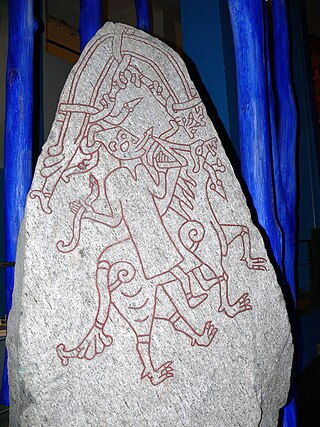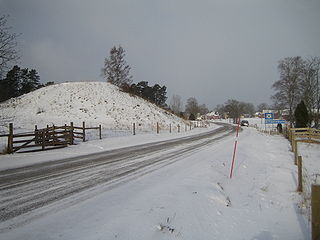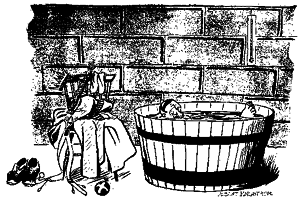
A galdr (plural galdrar) or ġealdor (plural ġealdru) refers to a spell or incantation in Old Norse and Old English respectively; these were usually performed in combination with certain rites. [1]

A galdr (plural galdrar) or ġealdor (plural ġealdru) refers to a spell or incantation in Old Norse and Old English respectively; these were usually performed in combination with certain rites. [1]
Old Norse : galdr and Old English : ġealdor or galdor are derived from the reconstructed Proto-Germanic *galdraz, meaning a song or incantation. [2] [3] The terms are also related by the removal of an Indo-European -tro suffix to the verbs Old Norse : gala and Old English :galan, both derived from Proto-Germanic *galaną, meaning to sing or cast a spell. [4] [5] In Old High German the -stro suffix produced galster instead. [6]
The German forms were Old High German galstar and Middle High German (MGH) galster "song, enchantment" (Konrad von Ammenhausen Schachzabelbuch 167b), surviving in (obsolete or dialectal) Modern German Galsterei (witchcraft) and Galsterweib (witch).
From these terms are descended words such as the Icelandic verb að gala "to sing, call out, yell", Middle English : galder "magic" and as a component of nightingale (from nihtegale), related to ġiellan, the verb ancestral to Modern English yell. [7] [8] The words are also cognate with Dutch gillen "to yell, scream".
Some incantations were composed in a special meter named galdralag . [9] This meter was similar to the six-lined ljóðaháttr , also used for ritual, but added at least one more C-line. [10] Diverse runic inscriptions suggest informal impromptu methods. Another characteristic is a performed parallelism, [10] see the stanza from Skirnismál , below.
A practical galdr for women was one that made childbirth easier, [9] but they were also notably used for bringing madness onto another person, whence modern Swedish galen meaning "mad", [11] derived from the verb gala ('to sing, perform galdr'). [12] Moreover, a master of the craft was also said to be able to raise storms, make distant ships sink, make swords blunt, make armour soft and decide victory or defeat in battles. [11] Examples of this can be found in Grógaldr and in Frithiof's Saga . [11] In Grógaldr , Gróa chants nine (a significant number in Norse mythology) galdrar to aid her son, and in Buslubœn , the schemes of king Ring of Östergötland are averted. [13]
It is also mentioned in several of the poems in the Poetic Edda , and for instance in Hávamál , where Odin claims to know 18 galdrar. [1] For instance, Odin mastered galdrar against fire, sword edges, arrows, fetters and storms, and he could conjure up the dead and speak to them. [14] [15] There are other references in Skírnismál , [1] where Skirnir uses galdrar to force Gerðr to marry Freyr [13] as exemplified by the following stanza:
34. Heyri jötnar, |
A notable reference to the use of galdrar is the eddic poem Oddrúnargrátr , where Borgny could not give birth before Oddrún had chanted "biting galdrar" [9] (but they are translated as potent charms, by Henry Adams Bellows below):
7. Þær hykk mæltu | 6. Then no more |
In Beowulf, gealdor is described as having been used to protect the dragon's hoard that was buried in a barrow:
Him big stódan bunan ond orcas | Beside them goblets and ewers stood, |
| —Old English text [20] | —Tolkien Translation [21] |
It was performed by both women and men. [9] Some scholars have proposed they chanted it in falsetto (gala). [9] [11]

The terms Jötunheimr or Jötunheimar refer to either a land or multiple lands respectively in Nordic mythology inhabited by the jötnar. Jötunheimar are typically, but not exclusively, presented in Eddic sources as prosperous lands located to the north and are commonly separated from the lands inhabited by gods and humans by barriers that cannot be traversed by usual means.

The Norns are deities in Norse mythology responsible for shaping the course of human destinies.

The Poetic Edda is the modern name for an untitled collection of Old Norse anonymous narrative poems. It is distinct from the Prose Edda written by Snorri Sturluson, although both works are seminal to the study of Old Norse poetry. Several versions of the Poetic Edda exist: especially notable is the medieval Icelandic manuscript Codex Regius, which contains 31 poems. The Codex Regius is arguably the most important extant source on Norse mythology and Germanic heroic legends. Since the early 19th century, it has had a powerful influence on Scandinavian literature, not only through its stories, but also through the visionary force and the dramatic quality of many of the poems. It has also been an inspiration for later innovations in poetic meter, particularly in Nordic languages, with its use of terse, stress-based metrical schemes that lack final rhymes, instead focusing on alliterative devices and strongly concentrated imagery. Poets who have acknowledged their debt to the Codex Regius include Vilhelm Ekelund, August Strindberg, J. R. R. Tolkien, Ezra Pound, Jorge Luis Borges, and Karin Boye.

A jötunn or, in Old English, eoten is a type of supernatural being in Germanic mythology. In Norse mythology, they are often contrasted with gods and other non-human figures, such as dwarfs and elves, although the groupings are not always mutually exclusive. The entities included in jötunn are referred to by several other terms, including risi, þurs and troll if male and gýgr or tröllkona if female. The jötnar typically dwell across boundaries from the gods and humans in lands such as Jötunheimr.

The Geats, sometimes called Goths, were a large North Germanic tribe who inhabited Götaland in modern southern Sweden from antiquity until the late Middle Ages. They are one of the progenitor groups of modern Swedes, along with Swedes and Gutes. The name of the Geats also lives on in the Swedish provinces of Västergötland and Östergötland, the Western and Eastern lands of the Geats, and in many other toponyms.

In Germanic paganism, a seeress is a woman said to have the ability to foretell future events and perform sorcery. They are also referred to with many other names meaning "prophetess", "staff bearer", "wise woman" and "sorceress", and they are frequently called witches or priestesses both in early sources and in modern scholarship. In Norse mythology the seeress is usually referred to as völva or vala.

Grógaldr or The Spell of Gróa is the first of two poems, now commonly published under the title Svipdagsmál found in several 17th-century paper manuscripts with Fjölsvinnsmál. In at least three of these manuscripts, the poems are in reverse order and separated by a third eddic poem titled, Hyndluljóð. For a long time, the connection between the two poems was not realized, until in 1854 Svend Grundtvig pointed out a connection between the story told in Gróagaldr and the first part of the medieval Scandinavian ballad of Ungen Sveidal/Herr Svedendal/Hertig Silfverdal. Then in 1856, Sophus Bugge noticed that the last part of the ballad corresponded to Fjölsvinnsmál. Bugge wrote about this connection in Forhandlinger i Videnskabs-Selskabet i Christiania 1860, calling the two poems together Svipdagsmál. Subsequent scholars have accepted this title.

Ohthere, Old Norse Óttarr vendilkráka was a semi-legendary king of Sweden of the house of Scylfings, who is said to have lived during the Germanic Heroic Age, possibly during the early 6th century.

Fjölnir is a legendary king in Norse mythology said to have been the son of Freyr (Frey) and his consort Gerðr (Gertha). The name appears in a variety of forms, including Fiolnir, Fjölner, Fjolner, and Fjolne. He was claimed as the progenitor of the Swedish Yngling dynasty, reigning from Gamla Uppsala. According to the Grottasöngr, Fjölnir lived from the 1st century BC to the early 1st century AD.

Blót and blōt or geblōt are terms for "blood sacrifice" in Norse paganism and Anglo-Saxon paganism respectively. A comparanda can also be reconstructed for wider Germanic paganism.

Helgi Hundingsbane is a hero in Norse sagas. Helgi appears in Volsunga saga and in two lays in the Poetic Edda named Helgakviða Hundingsbana I and Helgakviða Hundingsbana II. The Poetic Edda relates that Helgi and his mistress Sigrún were Helgi Hjörvarðsson and Sváva of the Helgakviða Hjörvarðssonar reborn. They were once again reborn as Helgi Haddingjaskati and Kára whose story survives as a part of the Hrómundar saga Gripssonar.

Norse funerals, or the burial customs of Viking Age North Germanic Norsemen, are known both from archaeology and from historical accounts such as the Icelandic sagas and Old Norse poetry.

Dragons, or worms, are present in Germanic mythology and wider folklore, where they are often portrayed as large venomous serpents. Especially in later tales, however, they share many common features with other dragons in European mythology.

Krákumál or the Lay of Kraka is a skaldic poem, consisting of a monologue in which Ragnar Lodbrok is dying in Ælla's snake pit and looks back at a life full of heroic deeds. It was composed in the 12th century, almost certainly in the Scottish islands. It is composed in a kind of háttlausa in 29 stanzas, most of them with ten lines. Thomas Percy was the first to translate the poem into English.

Kjárr, or Kíarr, is a figure of Germanic heroic legend that is believed to be the reflection of the Roman Emperors. In Old Norse sources, he appears as a king of the Valir who were the people of Valland.
In Norse legend, Valland is the name of the part of Europe which is inhabited by Celtic and Romance peoples. The element Val- is derived from *Walhaz, a Proto-Germanic word whose descendants were used in various Germanic languages to refer to the inhabitants of the Western Roman Empire.

Sigurðarkviða hin skamma or the Short Lay of Sigurd is an Old Norse poem belonging to the heroic poetry of the Poetic Edda. It is one of the longest eddic poems and its name derives from the fact that there was once a longer Sigurðarkviða, but this poem only survives as the fragment Brot af Sigurðarkviðu.

Death in Norse paganism was associated with diverse customs and beliefs that varied with time, location and social group, and did not form a structured, uniform system. After the funeral, the individual could go to a range of afterlives including Valhalla, Hel and living on physically in the landscape. These afterlives show blurred boundaries and exist alongside a number of minor afterlives that may have been significant in Nordic paganism. The dead were also seen as being able to bestow land fertility, often in return for votive offerings, and knowledge, either willingly or after coercion. Many of these beliefs and practices continued in altered forms after the Christianisation of the Germanic peoples in folk belief.
Norse religious worship is the traditional religious rituals practiced by Norse pagans in Scandinavia in pre-Christian times. Norse religion was a folk religion, and its main purpose was the survival and regeneration of society. Therefore, the faith was decentralized and tied to the village and the family, although evidence exists of great national religious festivals. The leaders managed the faith on behalf of society; on a local level, the leader would have been the head of the family, and nationwide, the leader was the king. Pre-Christian Scandinavians had no word for religion in a modern sense. The closest counterpart is the word siðr, meaning custom. This meant that Christianity, during the conversion period, was referred to as nýr siðr while paganism was called forn siðr. The center of gravity of pre-Christian religion lay in religious practice – sacred acts, rituals and worship of the gods.
Gro Steinsland is a Norwegian scholar of medieval studies and history of religion and since August 2009 has been the Scientific Director of the Centre for Advanced Study at the Norwegian Academy of Science and Letters.